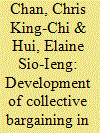|
|
|
Sort Order |
|
|
|
Items / Page
|
|
|
|
|
|
|
| Srl | Item |
| 1 |
ID:
131958


|
|
|
|
|
| Publication |
2014.
|
| Summary/Abstract |
2010 was a turbulent year for labour relations in China. The wave of strikes sparked by the Honda workers has highlighted the urgent need for trade union reform and workplace collective bargaining. In response to this turbulence, the Chinese government has stepped up efforts to promote the practice of collective bargaining, which had been neglected under the existing "individual rights-based" labour regulatory framework. In the midst of rapid social and policy changes, this article aims to examine the effect of labour strikes on the development of collective bargaining in China. The authors argue that, driven by growing labour protests, the collective negotiation process in China is undergoing a transition, from "collective consultation as a formality," through a stage of "collective bargaining by riot," and towards "party state-led collective bargaining." This transition, however, is unlikely to reach the stage of "worker-led collective bargaining" in the near future.
|
|
|
|
|
|
|
|
|
|
|
|
|
|
|
|
| 2 |
ID:
129806


|
|
|
|
|
| Publication |
2014.
|
| Summary/Abstract |
Before the 21st century, Chinese presence in Libya was minimal. In the last years of the Gaddafi regime, however, a large-scale temporary migrant community quickly formed. Then, as unrest in Libya increased, the community was withdrawn abruptly in early 2011 in China's first officially organized mass evacuation. This short-lived community does not display the characteristics associated with Chinese migration to Africa as a whole, suggesting the necessity of local ethnographic case studies across the continent to form a more accurate and complete picture. Migration was spurred by labour contracted by state-owned enterprises (SOEs) from all over China, and did not feature private traders except for those who provided services for the labourers. It is probable that any recurrence of Chinese migration into Libya will again be SOE-driven, although favourable attitudes and policies on the part of the post-Gaddafi administration could possibly engender a more autonomous minority.
|
|
|
|
|
|
|
|
|
|
|
|
|
|
|
|
| 3 |
ID:
179130


|
|
|
|
|
| Summary/Abstract |
Chinese immigration to the Philippines has traditionally been studied in relation to commercial activities. But between 1850 and 1898, there was an unparalleled influx of Chinese labourers, which raised the number of Chinese residents to 100,000. This influx was fuelled by the abundant profits obtained by Chinese brokers and foremen, Spanish institutions and authorities in Manila, consuls in China, and Spanish and British ship captains, all of whom extracted excessive fees and taxes from the labourers. The trade in and the exploitation of Chinese labourers in the Philippines have yet to be thoroughly researched. This article shows that the import and abuse of Chinese labourers in and to the Philippines continued throughout the second half of the nineteenth century, and that, despite some anti-Chinese Spanish colonial rhetoric, a wide range of actors and institutions, both in China and in the Philippines, took advantage of this unprecedented inflow of immigrants.
|
|
|
|
|
|
|
|
|
|
|
|
|
|
|
|
|
|
|
|
|